A full moon lit up the Texas Hill County as I drove to a hunt just south of Kerrville. I made a game out of adding up the value of the axis deer roaming wild on the roadside. $100,000 on the hoof? It was starting to add up to some real money. An Axis buck would make a gorgeous mount, but for this hunt, my intended trophy would be more precious: game to fill the freezer.
A couple weeks earlier I called up Bryan Wilson of Frio County Hunts and threw a few challenges his way. I was hoping Bryan could get me on some big pigs, but my budget was meager and I really only had one day to hunt over the next month. Oh, and I like to hunt with an open sighted revolver.
As it would be a full moon when the hunt was to be scheduled, Bryan said he could get me on some big pigs (and boy can he ever), but they’d all be coming at night.
Hunting pigs at night with an open sight revolver is a particularly inadvisable approach to the business at hand. Even with a spotlight illuminating the target, you have to choose: pigs or sights? You can’t see both. You need to see both.
So I resigned myself to harvesting Mr. Pig with night vision and a suppressed AR pattern rifle, as is the common practice.
Then Bryan called with a different option. Frio County Hunts specializes in low fence Hill Country predator, pig, and white tail deer hunts. But Bryan knew a local land owner with some Red Deer. A high-fence Red Stag was outside of my budget, but since I was interested in a freezer trophy anyway, Bryan asked if a low fence spike or Red Hind would work?
Heck yeah it would work and now that I knew my quarry, I could return to my weapon of choice.
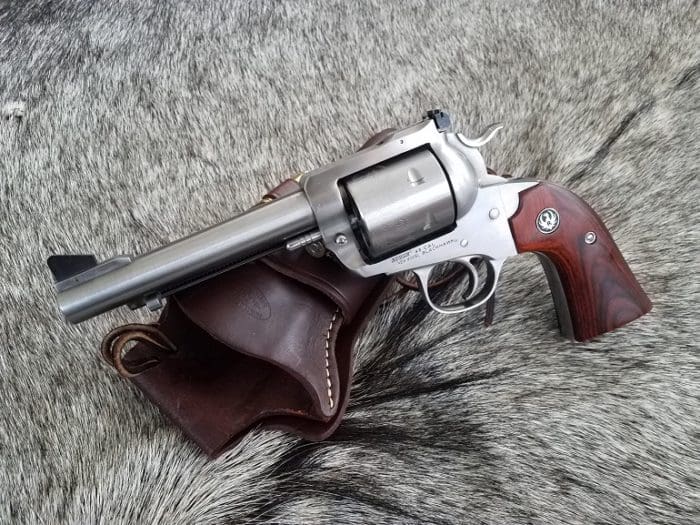
During the previous year, I’d dedicated myself to hunting with open sight revolvers, mostly Ruger single action New Model Blackhawks.
I’d pursued my quarry with .45 Colt “Ruger Only” loads. My chosen ballistic recipe: a 310 gr Cast Performance bullet. Exiting the muzzle at 1,200 fps, the load proved perfectly and reliably lethal on the Hill Country’s smaller-sized white tail deer and wild pigs.
Internet searches of Red Deer led me to conclude they were larger than the deer and pigs that had succumbed to my favored .45 Colt. Much larger.
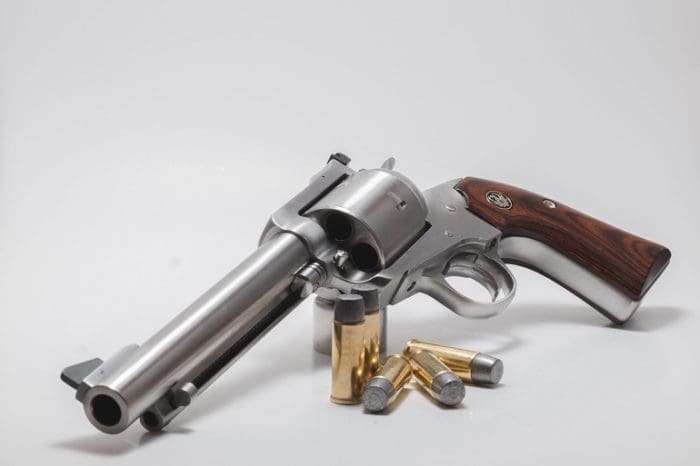
I decided a new purchase, the Ruger Super Blackhawk Bisley in the almost forgotten .480 Ruger would be my tool of choice for the hunt.
The Ruger Super Blackhawk Bisley gives buyers plenty of BANG! for their big bore buck. They are relatively inexpensive to purchase and to modify, parts are plentiful and their general design makes for a reliable, powerful revolver.
I found two commercial rounds at two of my local guns stores. Those were the 325 gr Hornady XTP and the 275 gr Speer Gold Dot Hollow Point. The Hornady factory load is leaving the muzzle at 1,350 fps, and the Speer is moving 100 fps faster than that. Either of these loads would do a number on wild pigs, black bear, or any white tail or mule deer that ever lived.
But in terms of prey and projectile both, I was interested in something bigger. The massive 410 grain hard-cast lead gas-checked flat-nosed bullet from Cast Performance would be my bullet of choice.
Working up a load with Winchester 296 powder, I eventually settled on a charge that would print extremely consistent two-inch five-shot groups at 25 yards off a rest. This heavily lubricated and tightly crimped round exists the muzzle at 1,250 fps.
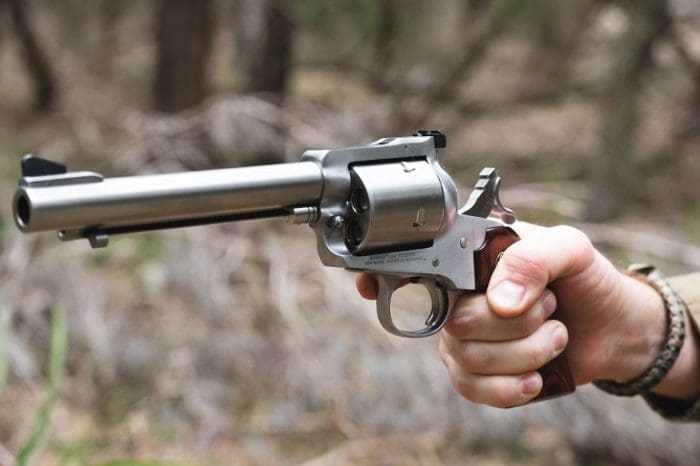
Sure in my choice of revolver and round, I packed the pistol in its simple holster and loaded up the biggest cooler I owned.
I met up with Joe Esparza, a buddy of mine who would be photographing the hunt, as well as Bryan at an intersection near the ranch where we would be hunting.
The ranch wasn’t regularly hunted. There were no blinds or other traditional Texas-style hunting structures. To get within handgun range, Bryan set up a pop-up blind in a clearing where the ranch owner often set protein in a small trough style feeder.
We arrived about 30 minutes prior to sunrise and settled in. As the valley in front of us was illuminated, I was greeted with the rugged beauty of a Texas Hill Country landscape.
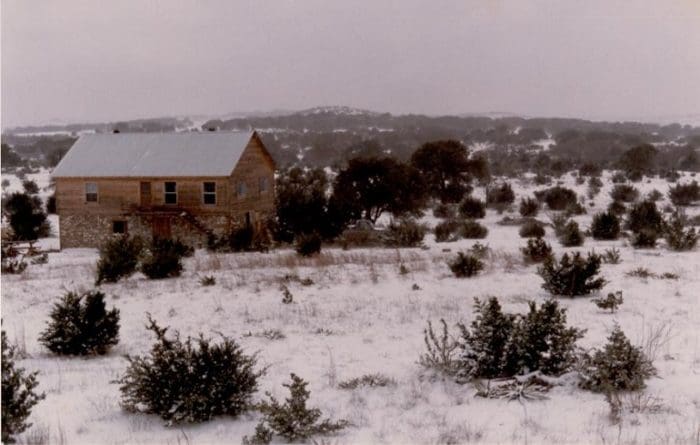
Fleeing the gulf coast and the wake of Hurricane Allen, my family moved to this area when I was a small child. Since then, I have travelled the world for fun, for work, and for war, but I’ve always returned to the refuge of the limestone and live oaks.
Dawn showed up. The deer didn’t.
Joe and Bryan served as Marines in Iraq. I was an Army medic in Afghanistan.
We passed a couple of hours talking about our time in the service, our post-deployment experiences, and the people and places we know and knew. Combat veterans make up less than 1% of the American population, scattered across the earth. And yet, somehow, we all know each other. The War on Terror is like one hot, sandy Kevin Bacon and nobody’s more than two degrees of separation apart.
To our left, down the tracks of a dirt road, a stag appeared.
Alone and adolescent, he was between his winter and summer coats. He was perfectly healthy, but the large sections of hair that had shed around his neck, as well as his youth, made him appear weird, gangly and unkept. Brother, I have been there.

He made it within 100 yards and stopped. I watched him curl his lip up and stick his tongue out. A wave in the little blue stem grass around us told the story. The wind shifted and pushed our scent toward him. Alone as he was, he had no use for our company.
He walked around the clearing in front of us, crossed an arroyo, and moved towards the hill opposite us.
As we watched him climb the hill, disappointment was overcome by hope. Other stags came into view.
Until that morning, I’d never seen one walking about, and when I saw the adolescent male, I considered them to be fairly sizable animals. When our shy new friend met up with his bachelor group, I got a glimpse of the size of an adult red stag. He dwarfed our young friend. My first thought: I need a bigger gun.
I am not unfamiliar at all with the Ruger Blackhawk and Super Blackhawk. In just over 30 years, I’ve used these revolvers to harvest dozens of deer, a few javelina and innumerable pigs. The .480 Ruger, however, was entirely new to me.
Prior to the hunt, I spent a little over 200 rounds testing some commercial loads, as well as working up my accurate, powerful big-game hunting load for the gun.
My home-rolled round sported some high numbers in foot-pounds of energy delivered, but no matter the arithmetic, I had never personally seen its effect on game as large as anything I was looking at. I was now unsure of the round, and more importantly, my capability with it.
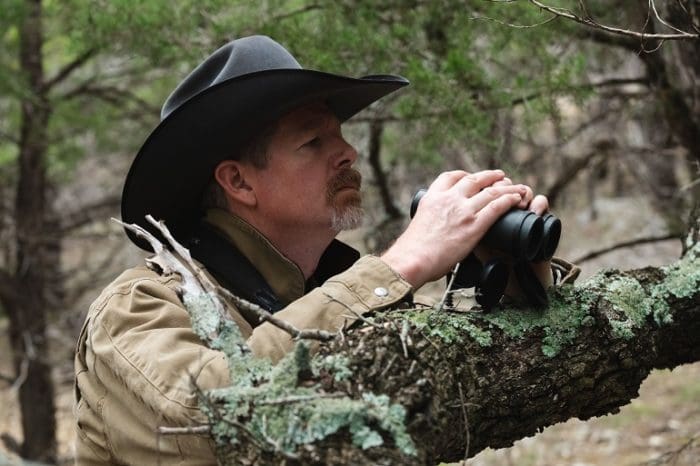
Bryan and I spied more tan rumps in the hills above us. Soon enough, the bachelor group slowly headed up in elevation. Hoping that they would lead us to the hinds, we left the blind and stalked after them.
The faint sounds of hooves and flashes of tan rumps through the cedars lured us higher into the limestone hills. I could see two big bodies a couple hundreds yards away to our right and a bit below us, heading up a saddle. Bryan maintained visual contact with our original bachelor group and circled higher and left to see if any of them had a brunch appointment with a lady in their lives.
I hunkered down in a brush pile and waited for the deer below to walk up.
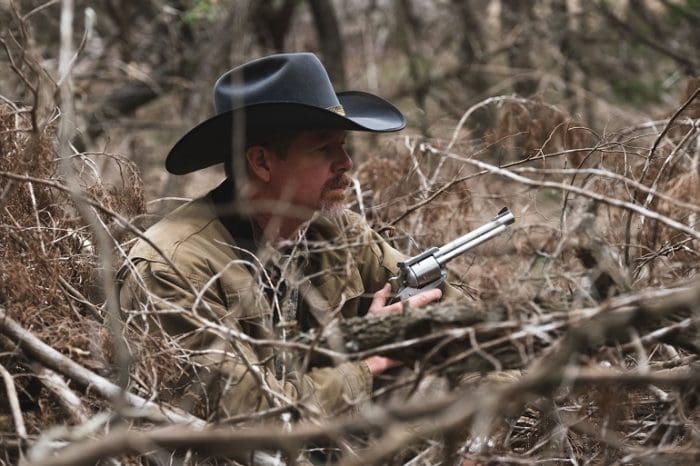
As I sat in the brush, I propped the gun up on the cedar limbs to take aim along a trail leading up and out of the draw. If things went well, the deer would pass within 30 yards of my position, a relatively easy shot. As I aimed, I was reminded of one of the few things I don’t like about these Ruger revolvers: the sights.
The Super Blackhawk Bisleys have fixed serrated ramp front sights and adjustable rear sights. They are well enough made, but all of the surfaces are flat black. There’s no white outline around the notch of the rear site, and no coloration on the front.
Sitting there in a shadow, aiming in a shadowed area, I was likely to be looking at a dark brown target, focusing on a dark front sight, through a dark rear notch with confidence as not as high as it might have been. Still, at such a short range, I hoped it wouldn’t matter.
It didn’t matter a bit. The first thing I saw of the animals as they ambled up the draw? Their antlers.

I headed up the hill and met back up with Bryan. We watched as the entire group, now five adult males, traveled to the back side of the hill and into the safety of the thick brush below.
Glassing from up top would prove fruitless, so we decided to get a Polaris Ranger from the ranch owner and head to the far side of the property.
A considerably braver man than I, the owner opted to drive the short way. We were practically vertical driving down one side of the hill – and then straight up the other. Once at the top, we followed a ridge line to get to an area where we could glass.
Just as we took a tight turn through the brush, a healthy spike bounded down the back side of the ridge we were traveling across. Low fence spikes were fair game.
I hopped out of the vehicle and went after him, big iron in-hand. Sneaking up behind him with a cedar tree for cover, I heard him bound straight down the other side of the ridge and into a steep canyon. Holstering my revolver, I hurried after him.
About the third time I slipped and fell down the canyon rocks I realized that all four of his legs were younger and surer than my two, and this was a losing battle. I made the decision to mount a tactical withdrawal.
It was now past noon, and knowing he was somewhere between the two ridge lines, we would spend hours trying to box him in and get a stalk on him, to no avail.
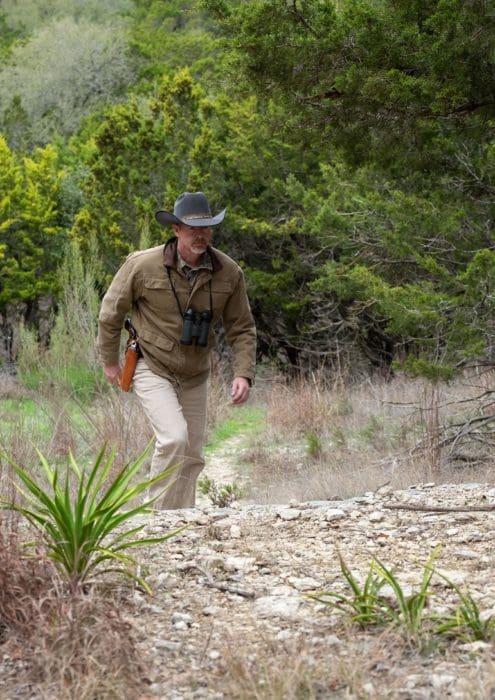
Although I had no shot to take with it, I was pretty glad I had chosen to hunt with a mid-weight hunting revolver. At 48 oz., the .480 Ruger Bisley weighs about a full glass of water more than a standard 1911 Government. In this configuration, it is easily carried in a strong-side hip holster.
There are more powerful guns, such as the .460 and .500 S&W Magnums, but those guns weigh considerably more, and are usually ported or otherwise compensated for recoil. The Bisley carries better, draws easier, and is far less obnoxious in muzzle blast and noise. Walking up and down the ridges that day, I was grateful for the sidearm on my hip, as opposed to a heavier rifle in my hands.
My day’s hunting was fading fast. We hadn’t spotted a female Red Deer, and only briefly glimpsed a fleet-footed spike. We’d had an equal lack of success with blind hunting and spot-and-stalk methods. We decided that if we were going to fail, we wouldn’t work so hard at it.
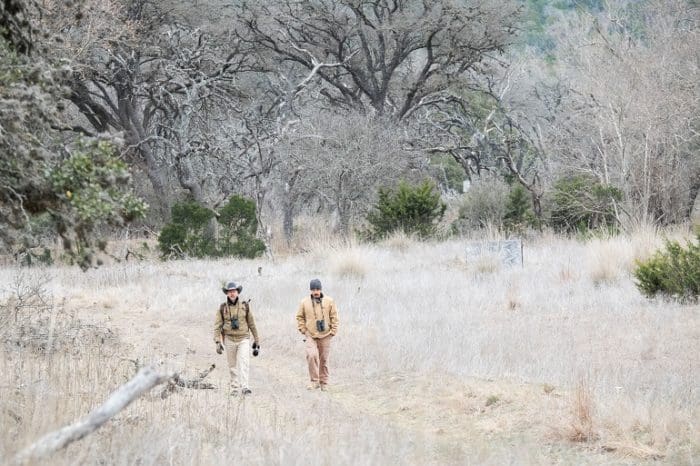
The ranch owner left with the Polaris. so we took a long stroll back to the blind.
At 4 pm, back in the blind, the entire bachelor group was in our little clearing, but cautious. They kept their distance, circling in front of us, catching our scent, and backing off. I was almost entirely sure this hunt would end without a round fired. Then Bryan got my attention.
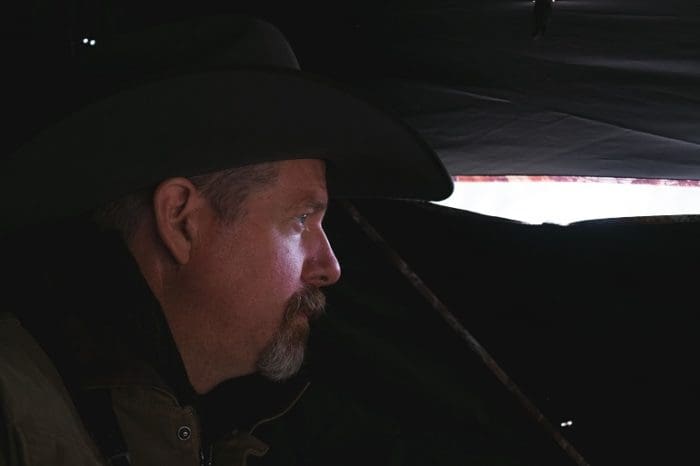
At the bottom of the opposite hill, in the same arroyo our gangly friend had crossed earlier that day, right in front of us, two females were rising up and heading toward the feeder trough.
An adolescent female was the first to come out, pushed by a mature adult hind. She was almost exactly the same color as her counterpart, but the mature female was a third larger. There were seven moving animals in front of me. Only one of them could be my target.
We’d been after these deer all day. What happened next lasted only a couple of minutes.
Until that moment, the stags were wary and uninterested in feeding. Suddenly, they charged the trough. They weren’t interested in mating – the stags were pushing the hinds away from their food.
The females ran, each alone and then together and apart again, to get to the trough without getting injured by the males. As there was only one animal among the herd I could shoot, the pandemonium of their giant brown and tan bodies was some kind of dusty, quadruped shell game.
At some point, I got a clear view of her front shoulder. I pressed the muzzle of the Ruger out of the blind’s front screen.
When we first arrived at the blind that morning, I used a laser range finder to note that the feeding trough was 61 yards away. At the range, from a bench, I was very comfortable putting a round inside a 10″ circle at 100 yards. My own experience has told me to halve that distance when in the field where hasty positions are more common. I had also practiced quite a bit shotting from kneeling without a rest at 50 yards, and was consistently printing 5-inch groups at that distance.
That meant that anything between me and the feeder was fair game, but anything past that was out-of-bounds.
I would have sworn – in a court of law – that the hind was between myself and the feeder, and to one side of it, when I unleashed my bullet. In reality, I shot when she was just over 10 yards beyond the feeder, and on the other side of it entirely.
It’s strange how the brain works. I certainly put my sights on her when she was on one side and closer, but as my focus narrowed to nothing other than my front sight and the spot on her shoulder I had chosen, everything else in the world ceased to exist.
I remember the serrations on my front sight. I remember the quiver of her hide when she ran. I remember it felt like the trigger pull was a mile long. I don’t remember the 350lb animal crossing behind the feeder, then turning again toward me, putting that same dark spot right over the Bisley’s front sight. The hammer fell.
It was a lousy shot. I fired as she turned and hit too far back.
Missing her shoulder altogether, my round punched a hole through her last rib as she was quartering toward me. Ignoring the bone, the massive bullet continued in a straight line, through her abdomen, and then through the top of her femur and pelvis, shattering both before exiting.
Her body bent as her legs went out from under her. She stumbled a total of 15 feet, and hit the ground. Shot placement is king, but a big heavy bullet sure will make up for some shooter error.
With her down, alive but immobile, I squeezed off a second shot. It looked like the ground just under her belly spit a pile of mud. Thinking I had somehow shot very low, I thumbed the hammer back and fired again, adjusting for a higher point of aim. The round kicked up dirt again, but this time well beyond her.
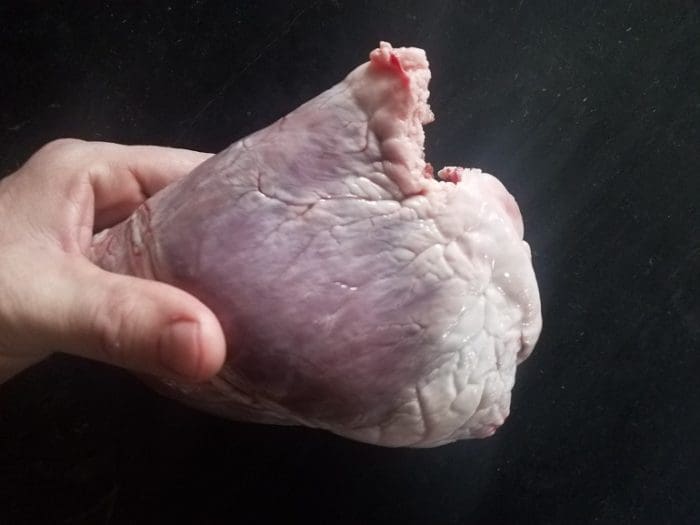
As she was still immobile, I sprinted out of the blind to get a better position for another shot. It wasn’t necessary. In the heat of the moment, perceptions were misleading, again.
That second shot, which I thought had missed low, had also struck true. The heavy bullet took a chunk out of her heart as it passed completely through her body, kicking up mud on the exit. It felt like minutes between shots. It was, as the thermal camera video would show, about 20 seconds.
It was impossible to miss the huge red holes in her thigh and side as I walked up. She was done.
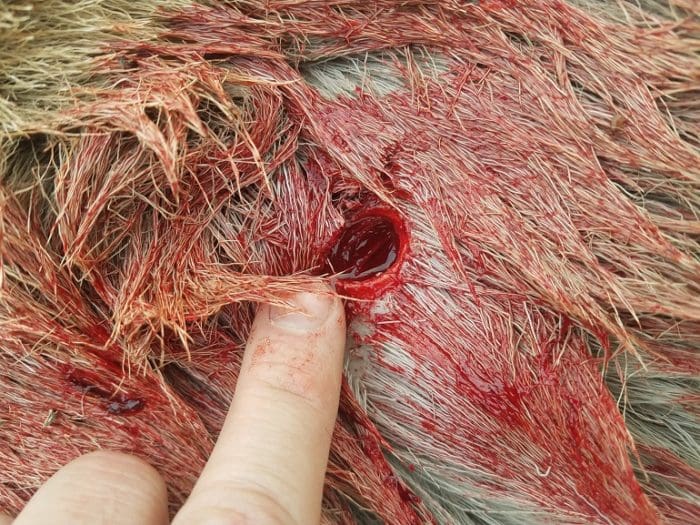
As Bryan walked over, I had a moment with just me and the animal.
In an ancient custom of the Old World, I put a little green grass around in her mouth, in the hopes that her last experience would not be terror, but the taste of the sweet greens. I said a traditional prayer of thanks for her sacrifice, and my own prayer of acknowledgement, a refrain I’m sure many an old soldier has voiced: “There, but by the grace of God, go I.”
Bryan and I quartered up the deer and shoe-horned the meat into a 75 gallon cooler. The heart had a healthy chunk taken from it, but it was still large enough to cut into slivers and pickle for snacks throughout the year. The large femur had been completely shattered, with a neat exit hole behind it. The heavy slug passed right through the big animal, impervious to anything in its path.
Several times throughout the day, especially when I saw how wary the deer were, I thought I’d go away from that hunt empty handed. Despite my poor first shot, and largely because of the exceptional performance of the round, I ended up with a lot more than just a nice walk through land I loved.
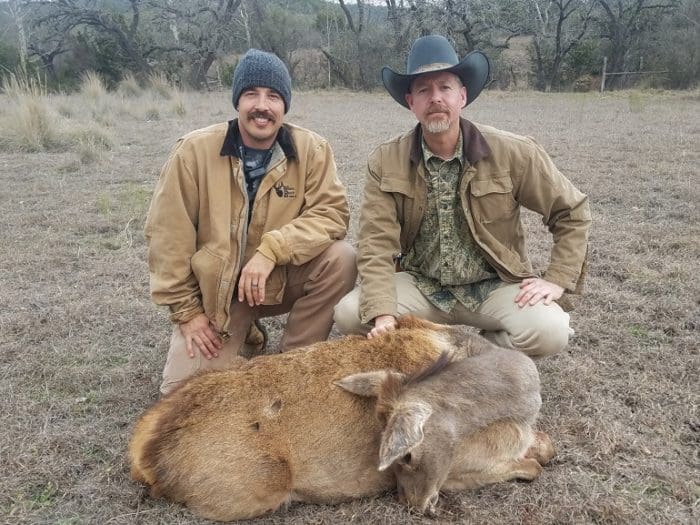
Bryan Wilson turned out to be not just a great guide, but a good dude, too. I would drive home with at least as much as I hoped for when I set out early that morning. I formed a friendship. My pistol was proven, and my freezer was full. I hiked the Hill Country. Fine trophies indeed.

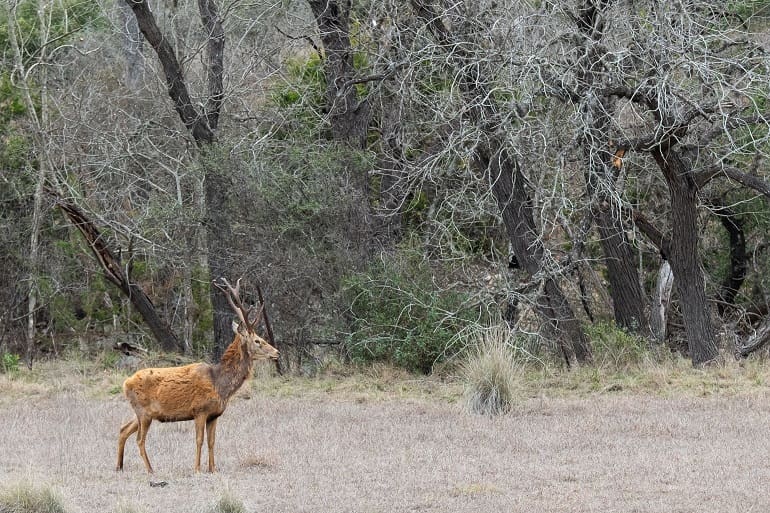


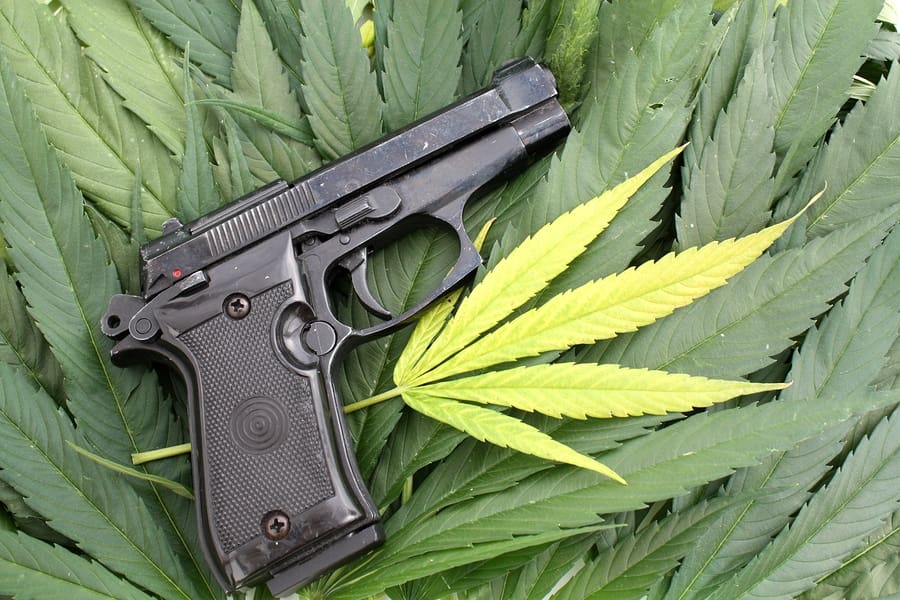
Thanks for sharing your story.
My next Axis hunt may be with a handgun.
JWT, Low fence high fence?
In this case it was a bit of both, if I remember. This was originally published a few years ago.
Congratulations on your catch but I don’t understand the definition. Low fence high fence meaning what? I’ve never hunted although filling up the freezer would be nice. And venison jerky is awesome!
I’m sorry I thought you were asking if the animal was hunted behind a high fence, sometimes referred to as a game proof fence, or a low fence, which is sometimes referred to as free range.
Thanks for that. I appreciate the reply.
Great story, as always. Thanks for inviting us along.
Anyways –
“The Super Blackhawk Bisleys have fixed serrated ramp front sights and adjustable rear sights. They are well enough made, but all of the surfaces are flat black. There’s no white outline around the notch of the rear site, and no coloration on the front.”
Can’t a talented ‘smith cure that problem, once and for all, with some nice contrast?
And –
Say a Red buck catches a whiff of an Axis doe in heat, do they ever, uhm, you know? What’s that make, an Axis Red?
A talented smith can do just about anything to a blackhawk or super Blackhawk. This particular gun has since had a complete accuracy package and trigger job done as well as custom sights and grips made to fit my hand.
A Ruger Bisley Super Blackhawk .44 Mag is one of my trip over it and buy it revolvers. 5 1/2″. Stainless. Thank you. However, I will take blue. An El Paso Saddlery Tom Three Persons holster and gunbelt. I’m good off the beaten path.
“What’s that make, an Axis Red?”
Only if you are staring at them…
I’m genuinely curious, horses and mules can make a donkey (or is it horses and donkeys make mules), do Axis and Reds just ignore each other, or does deer love occasionally blossom?
And apparently Jon was offended at my question… 🙁
No idea if they are compatible but it’s extremely unlikely. It would be like white tail deer mating with elk.
JW. If you ever see a whitetail buck passing through with flowers, chocolate and a step ladder, follow him. It could be a National Geographic moment.
“It would be like white tail deer mating with elk.”
Ahh, OK.
A height issue? I’ve heard of a Chihuahua knocking up a full-size dog… 🙂
But I thought it was cheaper to hunt in Africa then Texas?
It is!
Unless I’m looking at the wrong one, that’s a $1k gun. Inexpensive it is not
Tacitus, I don’t know where you live, but around here a quality handgun starts at $1000. The plastic pistols not withstanding.
Prices have gone up since this article was written, but yeah, I’d put $1k at a starting point for a big bore single action, and a bargain at that.
I spent near a grand for my Ruger gp100-7 about a year or so ago. But I live in CA. Everything is more expensive here.
Open sights in the Nite time.
Should have the guy with the light stand behind you and light up the sights and the quarry.
That’s the way we used to do it coon hunting.
Kids nowadays, whew.
Can’t tree a pig.
Bark louder
From the article:
“When our shy new friend met up with his bachelor group, I got a glimpse of the size of an adult red stag. He dwarfed our young friend. My first thought: I need a bigger gun.”
Um, no. A .48 caliber, 410 grain hardcast lead bullet exiting the muzzle at 1,250 feet per second will promptly kill pretty much anything with shot placement to the heart/lungs, assuming you limit your range to about 50 yards.
I have to think that caliber, load, and bullet weight/construction are more than adequate to take caribou, elk, moose, and even Kodiak brown bears. Note that a 410 grain projectile with a muzzle velocity of 1,250 feet-per-second is right on the heals of popular 12 gauge shotgun slugs which weigh 1 ounce (437 grains) and exit the barrel at roughly 1,400 feet-per-second.
(I read credible articles about hunters who took large bison with .45 Colt loads of something like 360 grain hardcast lead bullets and muzzle velocities under 1,000 feet-per-second. Even that “paltry” bullet weight and muzzle velocity promptly dropped their large bison quarry.)
I’ve used testors enamel model paint on a few blacked out front sights. It was a cheap fix that worked ok.
Same here.
Clean your sights first with a powerful organic solvent such as automotive brake cleaner. (Spray a cotton swab with the brake cleaner and use that cotton swab to wipe down the surface that you are going to paint. Note that you may have to do that two or three times.)
Then, dip the very tip of a toothpick in your enamel paint and use that to apply the paint to your sight/s. Of course allow that enamel paint to dry for 24 hours–preferably exposed to mild heat–before using your firearm.
So Jon, that load is a little over 1420 ft. lbs ME. Does a Bisley shoot ” softer” than a regular plowhandle if you let it roll under recoil? I’m somewhat convinced my SBh is easier shooting with wood Hogues on it than the sticky rubber version.
Pb_fan59,
I have a full-size revolver chambered in .44 Magnum with 6-inch barrel and beautiful aftermarket wood grips. Those wood grips seem to fit everyone’s hand really well. Most importantly, the “backstrap” of those wood grips are a bit wider than rubber grips. For whatever reason, that large revolver with those wood grips is surprisingly comfortable to shoot.
Don’t get me wrong: no matter what revolver or grips you have, .44 Magnum with anywhere from medium-power to full-power Magnum loads generates substantial recoil. For whatever reason, that recoil is not at all uncomfortable with wood grips which have an excellent contour to fit your hand–including that somewhat wider “backstrap” surface.
“For whatever reason, that large revolver with those wood grips is surprisingly comfortable to shoot”
Grip shape means a lot more than grip material.
Is your Texas red deer the same as a European Red Stag? I ask because here in the PNW some ranchers raise them in captivity and sell their meat as elk meat. The animals here called European Red Stag, are considerably larger than the quarry in your photo. I hunt the coast range of Oregon for Roosevelt elk. We like to tease the eastern Oregon hunters for hunting the “small” elk (rocky mountain elk have more branched antlers but the antlers are not as thick and the elk are much smaller in the body than a Roosevelt elk.). Congratulations on a successful hunt.
Exactly the same.
Comments are closed.